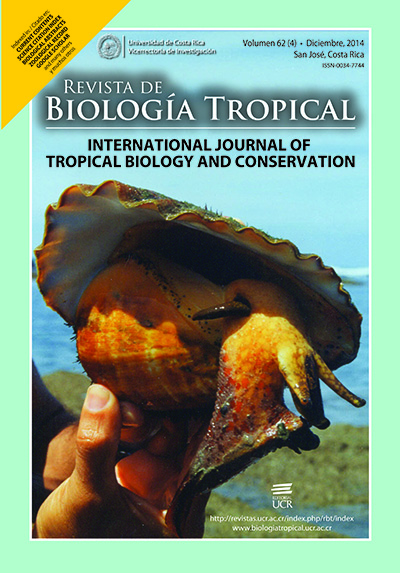Resumen
The genus Desmodium is represented in Santa Catarina State, Brazil, by 13 species, all with lomentaceous fruits. Shape, size and isthmus margin of loments vary, while the surface is glabrous, or covered by trichomes of different types. Morphological diversity of trichomes becomes particularly relevant to taxonomic description. The trichome types present on the surface of Desmodium fruits provide data for the identification and classification of species in the State. To assess this, three fruits of each species were collected and deposited at two herbaria, HBR and FLOR, in Santa Catarina, Brazil. Some rehydrated samples were examined using light microscopy (LM); and some sections were exposed to the following histochemical reagents: Sudan III for oils and Thionine for mucilage. The structural aspects of trichomes can be classified into uni- or multicellular and may still be simple, i.e., nonglandular or glandular. Using scanning electron microscopy (SEM), five types of trichomes were identified and analyzed among the Desmodium species studied: uncinate, uniseriate, globose multicellular, globose unicellular and subulate. Characteristics, such as loment margin and article form, glabrescent or pillous indument, trichome type, with or without papillous epidermal cells and epicuticular striations, showed relevant diagnostic value. An identification key was developed for Desmodium species from Santa Catarina State, Brazil, based on macro and micromorphological characters of the fruit.
Daiane M. Freitas1*, Ademir Reis2, Roseli L. da Costa Bortoluzzi3 and Marisa Santos4
- Departamento de Botânica, Universidade Federal de Santa Catarina (UFSC), Campus Universitário, Florianópolis 88040-900, Brasil and Herbário Barbosa Rodrigues (HBR), Av. Coronel Marcos Konder 800, Itajaí 88301-302, Santa Catarina, Brasil; martinsf.daiane@gmail.com
- Herbário Barbosa Rodrigues (HBR), Av. Coronel Marcos Konder 800, Itajaí 88301-302, Santa Catarina, Brasil; ademir.reis.ufsc@gmail.com
- Centro de Ciências Agrárias, Departamento de Engenharia Florestal, Universidade do Estado de Santa Catarina (CAV - UDESC), Lages 88520-000, Santa Catarina, Brasil; rosebortoluzzi@gmail.com
- Departamento de Botânica, Universidade Federal de Santa Catarina (UFSC), Campus Universitário, Florianópolis 88040-900, Brasil; marisa.santos@ufsc.br
* Correspondence
Citas
Agbagwa, I. O. & Okoli, B. E. (2005). Fruit Epidermal Micromorphology in the Systematics of Abrus Adanson (Papilionaceae) in Parts of Tropical West Africa. Asian Journal of Plant Sciences, 4(6), 652-659.
Akcin, O. E. (2008). Seed coat and fruit surface micromorphology of some Cynoglossum L. (Boraginaceae) species. Bangladesh Journal of Botany, 37(2), 115-119.
Ávalos, S. V. & Salinas, A. D. (2003). Los tricomas foliares en la caracterización de un grupo de especies del género Quercus, sección Lobatae (Fagaceae). Anales del Instituto de Biología, Universidad Nacional Autónoma de México, Serie Botánica, 74(1), 5-15.
Azevedo, M. G. (1981). O gênero Desmodium Desv. no Brasil: considerações taxonômicas (Master’s thesis, Universidade Estadual de Campinas, Brasil). Retrieved from http://www.bibliotecadigital.unicamp.br/document/?code=vtls000075165
Barroso, G. M., Morim, M. P., Peixoto, A. L., & Ichaso, C. L. F. (1999). Frutos e sementes - morfologia aplicada à sistemática de dicotiledôneas. Viçosa: Editora UFV.
Barthlott, W. (1990). Scanning electron microscopy of the epidermal surface in plants. In D. Claugher (Ed.), Scanning Electron Microscopy in Taxonomy and Functional Morphology (pp. 69-94). Oxford: Clarendon Press.
Barthlott, W., Neinhuis, C., Cutler, D., Ditsch, F., Meusel, I., Theisen, I., & Wilhelmi, H. (1998). Classification and terminology of plant epicuticular waxes. Botanical Journal of the Linnean Society, 126(3), 237-260.
Bersier, J. D. & Bocquet, G. (1960). Les méthodes d’éclaircissement en vascularisation et en morphogénie vegetables comparés. Archives des Sciences, 13, 555-566.
Costa, A. F. (1982). Farmacognosia: farmacognosia experimental. Lisboa: Fundação Calouste Gulbenkian.
Cutter, E. G. (1978). Plant anatomy. London: Edward Arnold Publishers.
Fahn, A. & Cutler, D. F. (1992). Xerophytes. Germany: Gebrüder Borntraeger.
Holmgren, P. K., Holmgren, N. H., & Barnett, L. C. (1990). Index Herbariorum Part I: The Herbaria of the World. New York: New York Botanical Garden.
Kaya, A., Ünal, M., Özgökçe, F., Doğan, B., & Martin, E. (2011). Fruit and seed morphology of six species previously placed in Malcolmia (Brassicaceae) in Turkey and their taxonomic value. Turkish Journal of Botany, 35, 653-662.
Larcher, W. (2000). Ecofisiologia Vegetal. São Carlos: Editora Rima.
Lima, L. C. P., Oliveira, M. L. A. A., & Tozzi, A. M. G. A. (2014). Desmodium Desv. In Lista de Espécies da Flora do Brasil. Rio de Janeiro: Jardim Botânico do Rio de Janeiro. Retrieved from http://floradobrasil.jbrj.gov.br/jabot/floradobrasil/FB22930)
Lima, L. C. P. (2011). Estudos Filogenéticos em Desmodium Desv. (Leguminosae-Papilionoideae) na América do Sul e Revisão Taxonômica das Espécies Brasileiras (Doctoral Dissertation, Universidade Estadual de Feira de Santana, Brasil). Retrieved from http://www2.uefs.br/ppgbot/pdf_dissertacoes_teses/doutorado/2011/TeseFinal_LauraLima.pdf
Monteiro, W. R., Castro, M. M., & Giulietti, A. M. (1985). Aspects of leaf structure of some species of Leiotrix Ruhl. (Eriocaulaceae) from Serra do Cipó (Minas Gerais, Brasil). Revista Brasileira de Botânica, 7, 137-147.
Ohashi, H. (2014). Tribe Desmodieae. In G. P. Lewis, B. Schrire, B. Mackinder, & M. Lock (Eds.), Legumes of the World. Kew: Royal Botanic Gardens.
Oliveira, M. L. A. A. (1983). Estudo Taxonômico do gênero Desmodium Desv. (Leguminosae, Faboideae, Desmodieae). Iheringia, Série Botânica, 31, 37-104.
Oliveira, M. L. A. A. (1990). Adições para o gênero Desmodium Desvaux (Leguminosae-Faboideae) no Rio Grande do Sul, Brasil. Iheringia, Série Botânica, 40, 77-87.
Ritter, M. R. & Miotto, S. T. S. (2006). Micromorfologia da superfície do fruto de espécies de Mikania Willd. (Asteraceae) ocorrentes no Estado do Rio Grande do Sul, Brasil. Acta Botanica Brasílica, 20, 241-247.
Setubal, R. B., Lima, L. C. P., & Grings, M. (2010). Espécie campestre provavelmente extinta (Desmodium craspediferum Azevedo & Oliveira, Fabaceae) reencontrada no Rio Grande do Sul, Brasil. Revista Brasileira de Biociência, 8, 432-438.
Werker, E. (2000). Trichome Diversity and Development. In D. L. Hallahan & J. C. Gray (Eds.), Advances in Botanical Research Incorporating Advances in Plant Pathology: Plant Trichomes (Vol. 31, pp. 1-35). London: Academic Press.
##plugins.facebook.comentarios##

Esta obra está bajo una licencia internacional Creative Commons Atribución 4.0.
Derechos de autor 2014 Revista de Biología Tropical






